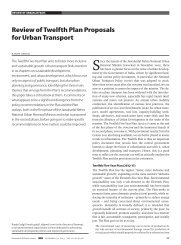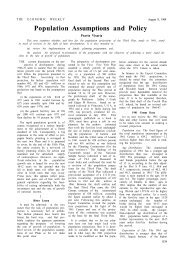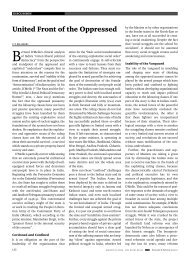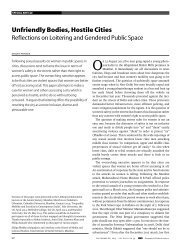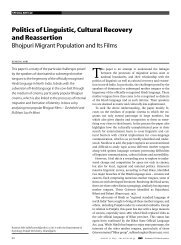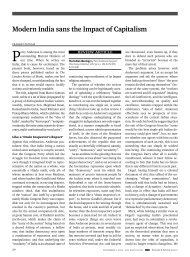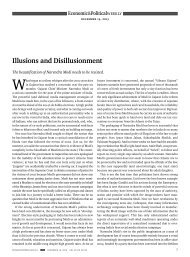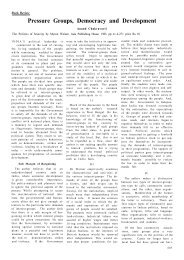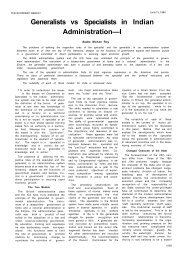Download PDF version - Economic and Political Weekly
Download PDF version - Economic and Political Weekly
Download PDF version - Economic and Political Weekly
You also want an ePaper? Increase the reach of your titles
YUMPU automatically turns print PDFs into web optimized ePapers that Google loves.
Official Documents<br />
WEST, SOUTH AND EAST<br />
— Contrasting Patterns in Europe's <strong>Economic</strong> Development<br />
March 20, 1954<br />
<strong>Economic</strong> Survey of Europe in 1953. <strong>Economic</strong> Commission for Europe, Geneva, 1954. Pages 314.<br />
Price 17sh 6d. Available from Oxford Book <strong>and</strong> Stationery Co, Scindia House, New Delhi.<br />
SINCE the latter part of 1952,<br />
there has been a relaxation of<br />
the strains which the economics of<br />
Western Europe had been experiencing<br />
ever since the war. Most of<br />
these countries increased their exports<br />
<strong>and</strong> had a favourable balance<br />
of payments with the dollar area.<br />
There has been an easing in payments<br />
relations with other overseas<br />
areas also, while within Western<br />
Europe, the payment problems<br />
" which have seemed to threaten a<br />
growing limitation of intra-Euro<br />
pean trade " have become less tense.<br />
Price levels within these countries<br />
were under little pressure, <strong>and</strong> the<br />
real income of the great majority of<br />
countries " benefited significantly<br />
from further improvements in the<br />
terms of trade between manufactures<br />
<strong>and</strong> primary commodities ".<br />
These developments however were<br />
not accompanied by " any strong <strong>and</strong><br />
unambiguous growth in the production<br />
<strong>and</strong> productive power of Western<br />
Europe ". While production in<br />
most countries did show improvement<br />
over 1952, the picture is a<br />
mixed one, <strong>and</strong> " the recovery is to<br />
be characterised as still somewhat<br />
hesitant". While trends in the<br />
consumer goods industries were<br />
generally satisfactory, there was an<br />
evident weakness of dem<strong>and</strong> for the<br />
products of the engineering <strong>and</strong><br />
metal using industries. In the face<br />
of a high level of orders for defence<br />
purposes, this obviously reflected a<br />
substantial decline in private investment<br />
dem<strong>and</strong>.<br />
The improvement of the external<br />
position was also due to special <strong>and</strong><br />
some temporary factors. The abnormally<br />
low level of dem<strong>and</strong> for imports<br />
by European countries <strong>and</strong><br />
the continued improvement in their<br />
terms of trade on the one h<strong>and</strong>, <strong>and</strong><br />
the growth of extraordinary external<br />
disbursements by <strong>and</strong> the maintenance<br />
of a high level of business<br />
activity in the United States which<br />
particularly favoured European exports<br />
were among such transient factors.<br />
"These considerations," the<br />
ECE suggests. " render somewhat<br />
problematical the ability of Western<br />
Europe to guard against serious consequences,<br />
cither external or internal,<br />
should recession tendencies in the<br />
United States become more pronounced."<br />
That the domestic situation had<br />
improved is shown by the fact that<br />
" in no country save Greece was<br />
there any significant increase in the<br />
cost of living <strong>and</strong> in a number of<br />
countries it fell". The continued<br />
fall in import prices must have<br />
helped " ro fortify the value of<br />
money ". Since wages continued to<br />
rise, usually more than in proportion<br />
to increases in productivity, there<br />
could be no reduction in labour costs,<br />
but the course of export prices suggests<br />
that there must have been sonic<br />
reduction in export profit margins<br />
" although in a number of cases<br />
this may have served only to close<br />
a previously existing gap between<br />
the rates of profit earned on foreign<br />
<strong>and</strong> domestic business ".<br />
At the same time, the improvement<br />
does nor appear to have been,<br />
" the product of any further tightening<br />
of monetary discipline ".<br />
Money supply increased <strong>and</strong> bank<br />
rates were reduced. The increase in<br />
liquidity due to export surpluses<br />
created some misgivings in West<br />
Germany <strong>and</strong> Switzerl<strong>and</strong>. These<br />
countries have had surpluses mainly<br />
with the European Payments Union<br />
<strong>and</strong> the undirected <strong>and</strong> unremunerative<br />
character of such foreign lend<br />
ing came in for serious criticism,<br />
particularly where, as in West Germany,<br />
internal capital needs were so<br />
great. The ECE, however, finds<br />
little reason to believe that investment<br />
in West Germany has been<br />
limited in any way by shortage of<br />
funds rather than by specific bottle<br />
necks or the willingness of industry<br />
to invest. The high rates of interest<br />
arc due more to the desire of the<br />
commercial banks to rebuild their<br />
capital <strong>and</strong> the absorption of ravings<br />
by certain Government departments<br />
as well as the unplanned cash surplus<br />
of the Government during<br />
1953. The Survey offers the expla<br />
333<br />
nation that the experience of two<br />
massive inflations has created a peculiar<br />
psychology among the German<br />
people of dem<strong>and</strong>ing too much for<br />
sacrificing their liquidity. In consequence,<br />
the paradoxical situation, may<br />
arise that in spite of the remarkable<br />
price stability which has been experienced<br />
since the currency reform, a<br />
country with great capital deficiency<br />
may need a substantial export<br />
surplus in order to maintain<br />
economic expansion.<br />
In France, the relaxation of inflationary<br />
forces coincided with a<br />
relapse in production but Government<br />
has been unwilling to increase<br />
publicly financed investment, being<br />
faced apparently with the dilemma<br />
of having to choose between monetary<br />
stability <strong>and</strong> economic expansion.<br />
The Survey points out, however,<br />
that a number of factors make<br />
this dilemma more apparent than<br />
real, the most important factor being<br />
" the appearance of agricultural surpluses<br />
<strong>and</strong> in particular, the disappearance<br />
of the bottleneck which<br />
has played a leading part in every<br />
inflationary crisis in the last decade—<br />
that ot meat ". There is thus a<br />
genuine possibility of expansion in<br />
France without inflation.<br />
In trade <strong>and</strong> payments within<br />
Europe, a relaxation of the strains<br />
evident in the earlier period was due<br />
mainly to a decline m the total of<br />
net surpluses <strong>and</strong> deficits which had<br />
to be offset through the Union.<br />
The persistent creditors, West Germany,<br />
Switzerl<strong>and</strong> <strong>and</strong> Holl<strong>and</strong> continued,<br />
however, to add to their surpluses<br />
dining 1953 <strong>and</strong> consequently<br />
"a large part of the credit in the<br />
Union is already frozen <strong>and</strong> a renewal<br />
of the pattern of deficits <strong>and</strong><br />
surpluses which developed in 1951<br />
would immediately bring into being<br />
acute strains."<br />
During this period, the FPU did<br />
not suffer because of the much more<br />
comfortable position which most<br />
Western European countries enjoyed<br />
with the dollar area, gold earned<br />
there making possible settlements of<br />
EPU deficits. However, the problem<br />
of intra-European credits remains<br />
since the FPU is not designed for<br />
long-term capital flows. Other channels<br />
will have to be found for this<br />
purpose.<br />
There was a significant change in<br />
the external position of the United<br />
States during 1953 which had its<br />
repercussions in Western Europe.<br />
From a surplus of $z,262 million m<br />
1952, the US balance of payments<br />
turned to a deficit of $44 million in<br />
the first three quarters of 1953. The<br />
replacement of economic aid by<br />
United States by military aid has
THE ECONOMIC WEEKLY March 20, 1954<br />
wider implications, though both types<br />
of expenditure are directly dependent<br />
on the US Government. But there<br />
have been important changes in<br />
US exports <strong>and</strong> imports also, " the<br />
steady decline of United States economic<br />
grants to Europe . .. has practically<br />
offset the doubling of European<br />
receipts from sides of goods <strong>and</strong><br />
services to the United States. . . ."<br />
European imports from the United<br />
States declined considerably during<br />
1953. So did the total imports of<br />
nearly all commodities between 1952<br />
<strong>and</strong> 1953, <strong>and</strong> only in three coinmodities—cotton,<br />
tobacco <strong>and</strong> sugar<br />
—" does there appear to have been<br />
a significant substitution " of non<br />
dollar for dollar imports. Nor has<br />
there been any significant increase in<br />
internal production except for a<br />
limited number of commodities.<br />
Since consumption has not shown<br />
a comparable fall, there must have<br />
been a considerable reduction in<br />
inventories. Therefore in the absence<br />
of further increases in nondollar<br />
production, " the present level<br />
of dollar imports cannot be taken as<br />
a true measure of Europe's normal<br />
needs."<br />
The rapid growth of military expenditure<br />
by the United States in<br />
Europe is likely, however, to absorb<br />
the shock of any increase in Europe's<br />
dollar expenditure that may occur in<br />
the near future. The analysis of<br />
European exports to the United<br />
States, however, leads to the depressing<br />
conclusion that a considerable<br />
part of these " is subject, to the<br />
influence not only of general cyclical<br />
fluctuations in United States industrial<br />
production but also of the particular<br />
course of its defence expenditure<br />
<strong>and</strong> production."<br />
That Western Europe is not likely<br />
to be faced with any dollar problem<br />
in the near future does not mean,<br />
therefore, that the dollar problem has<br />
been finally solved but rather that<br />
the sting has been taken out of it<br />
for the moment. The task of changing<br />
Europe's needs <strong>and</strong> earning<br />
capacity in a way winch will allow<br />
Western European countries to pay<br />
their way on dollar account on the<br />
basis of ordinary commercial transactions<br />
still remains to be completed.<br />
In its study of the Soviet Union<br />
<strong>and</strong> Eastern Europe, the ECE has<br />
attempted to collect evidence in<br />
view of the opinion that increasing<br />
consumption is to be permitted in<br />
these countries. " The main emphasis<br />
of the Soviet Government's statements<br />
on economic affairs during the<br />
past year," says the Survey, " has<br />
been on the need for <strong>and</strong> possibility<br />
of, a faster increase in st<strong>and</strong>ards of<br />
living than was envisaged when the<br />
Fifth Five-Year Plan was drawn up."<br />
But apart from statements made by<br />
officials <strong>and</strong> changes in attitudes,<br />
there is as yet no information on<br />
" the extent to which it is prepared<br />
to sacrifice part of the increase pre<br />
viously intended in the non-con<br />
sumption sector ". No revised plan<br />
for the whole economy has been published<br />
<strong>and</strong> though the Survey feels<br />
that the Soviet Union is in a position<br />
to increase consumption faster<br />
than usual while continuing to<br />
increase its Industrial capacity <strong>and</strong><br />
defence stockpiles at a rapid rate, it<br />
admits that the key question raised<br />
above cannot yet be answered.<br />
Consumers purchasing power was<br />
increased in the Soviet Union in<br />
1953 mainly through price cuts on<br />
a larger scale than usual <strong>and</strong> through<br />
reduction in taxation of fanners.<br />
The subscription to the State Loan<br />
called for was reduced by mere than<br />
half. The new targes that have<br />
been announced for 1954 <strong>and</strong> 1955<br />
show a dual approach. Ambitious<br />
increases over the original increases<br />
planned have been announced for<br />
metal goods, but where the raw<br />
materials of consumption industries<br />
come from agriculture, it is the<br />
greater probability of achievement of<br />
planned targets which is emphasis<br />
ed, in view of the closer attention<br />
being paid to agriculture <strong>and</strong> the<br />
extra investment announced. ' It<br />
may well be ,' says the Survey that<br />
' the most valuable sign to the Soviet<br />
consumer is not so much the upward<br />
revisions in formal plans as<br />
the evidence that a firmer attitude<br />
to plan fulfilment in the consumption<br />
sector is now to be taken'.<br />
Attention is also drawn to numerous<br />
complaints about inefficiency in<br />
the consumer goods industries thaiarc<br />
appearing in the Soviet press,<br />
This is the Soviet practice whenever<br />
reforms are in the air. In<br />
addition, a number of reforms have<br />
been announced in the retail network<br />
<strong>and</strong> a number of new shops<br />
are to be opened.<br />
While these changes in priorities<br />
can bring benefits to the consumer<br />
only in the next two or three years,<br />
" the consumer has already benefited<br />
largely through increases in his pur<br />
chasing power. The extra supplies<br />
needed to match this extra income<br />
came partly from stocks <strong>and</strong> partly<br />
from imports, which included fruit<br />
for the first time. Target figures for<br />
the next few years show that in<br />
general the output of consumer<br />
goods made by the engineering industries<br />
is now intended to be, by igssseveral<br />
times greater than in 1950,"<br />
The emphasis on the engineering<br />
335<br />
industries is due to fact that their<br />
raw materials are mainly prod need<br />
within the industrial sector itself.<br />
Thus it has been roughly estimated<br />
that, " the increase in supplies of<br />
durable consumer goods planned for<br />
1955 may involve the use of one<br />
<strong>and</strong>-a-half million tons in crude steel<br />
equivalent above that used in 1950,"<br />
while crude steel production will rise<br />
in the mean time by 17 million<br />
tons.<br />
In the more staple items of consumption,<br />
however, the concessions<br />
which could he granted to the consumer<br />
arc much more limited—for<br />
textiles <strong>and</strong> footwear, they have<br />
hardly changed from those originally<br />
planned—<strong>and</strong> the achievement of<br />
even these modest targets, " is closely<br />
dependent on the Soviet Union's<br />
success in meeting the difficult<br />
problems in agriculture." In agriculture,<br />
no changes have been made<br />
in targets, nor have measures to<br />
make achievement of gram targets<br />
easier been announced. There is a<br />
greater concentration, however, on<br />
improving supplies of livestock pro<br />
ducts, vegetables <strong>and</strong> fruit, in the<br />
production of which the collective<br />
farmer working on his private plot<br />
still makes an appreciable centribution.<br />
More emphasis is being given<br />
in agriculture to incentives for the<br />
attainment of targets <strong>and</strong> less to<br />
compulsion.<br />
For collective farms, these incentives<br />
took three forms during 1953<br />
Compulsory quotas paid for at very<br />
low prices were reduced for a number<br />
of commodities. The prices<br />
paid for such quotas were increased,<br />
considerably in some cases. Prices<br />
offered for additional supplies delivered<br />
to the State under contract were<br />
raised, <strong>and</strong> the State's selling prices<br />
were reduced. The total increase in<br />
farm income, after allowing for various<br />
factors, is expected to result in<br />
a 10 per cent increase in farm consumption<br />
of industrial products dm<br />
ing 1953.<br />
Eastern Europe followed the pattern<br />
set In the Soviet Union, but<br />
even less information is available<br />
about these countries. Previous to<br />
1953. " the Governments of all these<br />
countries had been giving the utmost<br />
priority to the development of heavy<br />
industry, to the relative neglect of<br />
the light manufacturing industries<br />
<strong>and</strong>, even more, of agriculture. Since<br />
the former had no incentive to produce<br />
more the Government had increasingly<br />
to use compulsion. In<br />
1953. they felt free "to permit some<br />
increase in the output of consumer<br />
goods <strong>and</strong> farmers' tools," The ECE<br />
feels, however, that the information<br />
available is "so far too small to
March 20, 1954<br />
allow of an exact estimate of the<br />
scope of the changes already made or<br />
in prospect ".<br />
The third part of the Survey this<br />
year contains a special study of<br />
<strong>Economic</strong> Development in Southem<br />
Europe, including six countries—<br />
Turkey, Greece, Yugoslavia, Southern<br />
Italy, Spain <strong>and</strong> Portugal. These<br />
countries form a distinct group, contrasting<br />
with western Europe<br />
through its much lower st<strong>and</strong>ards of<br />
living <strong>and</strong> with eastern Europe by<br />
fundamental differences in economic<br />
<strong>and</strong> political regime. Since the<br />
Mediterranean sea board was the<br />
cradle of European civilization, " they<br />
are countries of arrested economic<br />
development rather than countries<br />
which have not been acquainted with<br />
modem civilization."<br />
Only southern Italy is included<br />
in this group because ltaly as a<br />
whole cannot meaningfully be grouped<br />
with either western or southern<br />
Europe." The northern part of Italy<br />
is at a level of development comparable<br />
with that of several western<br />
European countries, while the<br />
southern part is at a level which is<br />
even lower than that of most of the<br />
other southern European countries.<br />
'tins situation raises special problems<br />
of regional development within a<br />
single country, <strong>and</strong> the ECE study<br />
of the problem is of wide interest.<br />
The relationship between southern<br />
<strong>and</strong> western Europe, the Survey<br />
suggests, has some analogy—on a<br />
much bigger scale—to that between<br />
southern <strong>and</strong> northern Italy. In<br />
both cases, a question of closer<br />
integration through the equalizing<br />
of economic levels is involved <strong>and</strong><br />
in both eases an important part of<br />
the problem is to find solutions,<br />
along the lines of expansion, which<br />
suit the interests of both regions.<br />
Such a solution must necessarily<br />
concentrate attention on agriculture<br />
in the first instance, The agricultural<br />
revolution which began in the<br />
United Kingdom in the eighteenth<br />
century did not reach these countries.<br />
Vast areas are still cultivated in a<br />
primitive <strong>and</strong> poor system of cereal<br />
monoculture. The main hindrance<br />
to progress is to be found in the<br />
social structure of agriculture, the<br />
poverty of farmers <strong>and</strong> the inertia of<br />
a largely illiterate farm population.<br />
These are interrelated factors. A<br />
concentrated public effort combining<br />
financial assistance with the propagation<br />
of improved methods of<br />
farming is necessary. The importance<br />
of increasing the marketable<br />
surplus of foodgrains is stressed in<br />
the light of the balance of payments<br />
difficulties that are likely to arise<br />
with industrialization.<br />
The problem of emigration is<br />
discussed as a possible means of<br />
relieving the population pressure in<br />
these countries <strong>and</strong> is rejected. The<br />
Survey is sceptical of the advantages<br />
of emigration from the long-term<br />
point of view. Emigration, as it is<br />
organised at present, is entirely in<br />
the interests of the receiving country,<br />
since the cost of bringing up has to<br />
be borne by the country of origin,<br />
while the best individuals in the<br />
country are lost to it during the<br />
most active period of their lives.<br />
There is a strong ease it appears for<br />
the emigration to other countries of<br />
Europe rather than elsewhere, particularly<br />
when it can be seasonal,<br />
For achieving a balanced development<br />
of southern Europe, the Survey<br />
advocates what may at first sight<br />
appear to be contradictory policies.<br />
The countries of western Europe, it<br />
is suggested, should be more liberal<br />
in their import policies in relation<br />
to the products of southern Europe<br />
which are mainly non-essential <strong>and</strong><br />
not easily marketable, such as wine,<br />
tobacco, dried fruits, citrus fruits <strong>and</strong><br />
vegetables. At present they are subject<br />
to the fourfold h<strong>and</strong>icap of<br />
import restrictions for balance of<br />
payments reasons, of projective measures<br />
in favour of higher cost domestic<br />
production in the importing<br />
countries, of discrimination in favour<br />
of producers in overseas countries<br />
affiliated with the United Kingdom<br />
or France <strong>and</strong>, finally, of export subsidies<br />
paid to United States producers.<br />
Relaxation of these conditions,<br />
achieved slowly by their stabilisation<br />
at existing levels in the face of growing<br />
dem<strong>and</strong>, is necessary for" the<br />
development of southern European<br />
countries <strong>and</strong> also desirable from the<br />
point of view of the western European<br />
countries.<br />
At the same time, tariff protection<br />
is suggested for the industries<br />
of southern Europe. "There is no<br />
inconsistency", the Survey argues,<br />
in advocating protection as regards<br />
the imports of less-developed countries<br />
<strong>and</strong> free trade as regards their<br />
exports ," In fact the existence side<br />
by side of highly developed <strong>and</strong> less<br />
developed countries makes it necessary.<br />
In fact, present tariffs in these<br />
countries are inadequate. The ECE<br />
suggests a flat rate of duty to be<br />
applied to all industrial products.<br />
This would meet the general need<br />
for protection in the less developed<br />
countries <strong>and</strong> still leave room, within<br />
each branch of industry, for specialisation<br />
on those products for which<br />
the countries concerned have special<br />
advantages.<br />
To encourage the flow of foreign<br />
capital into these countries <strong>and</strong> at<br />
336<br />
THE ECONOMIC WEEKLY<br />
the same time to solve the problem<br />
of finding export markets for the<br />
countries of western Europe, the<br />
Survey suggests a scheme by which<br />
the provision of capital from the<br />
.international agencies could be linked<br />
to the granting of export credits<br />
by western European countries. By<br />
this means, the countries of southern<br />
Europe would obtain much more<br />
capital than they could obtain from<br />
the international agencies alone <strong>and</strong><br />
at the same time there would be less<br />
risk of balance of payments difficulties.<br />
A proposal is also made for<br />
the extension of this scheme to<br />
northern Italy as an exporter of<br />
engineering goods, in relation to<br />
other countries of southern Europe.<br />
By exp<strong>and</strong>ing Italian exports of this<br />
kind to the southern European countries,<br />
northern Italy's engineering<br />
could be better utilised which in<br />
itself would give a strong impetus to<br />
capital formation.



